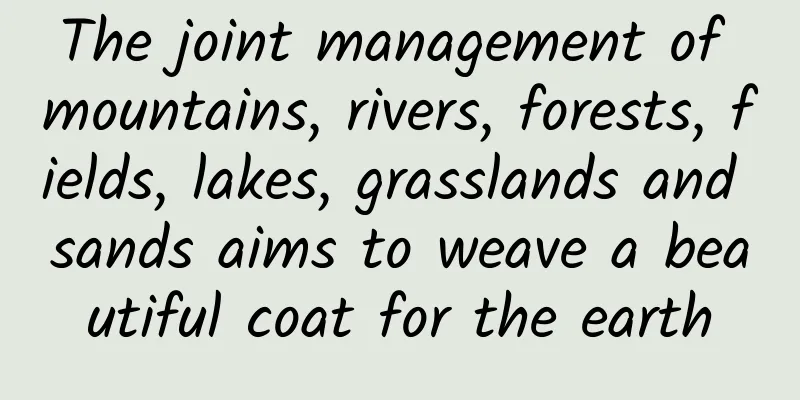The joint management of mountains, rivers, forests, fields, lakes, grasslands and sands aims to weave a beautiful coat for the earth

|
Some people say that deserts and desertified land are the "cancer" of the earth. However, rather than saying they are the "cancer" of the earth, it is better to say that in the process of human beings using the land, they have accidentally "torn" a part of the beautiful outer coat of the earth's surface. The occurrence and development of deserts and desertification have their natural causes, such as climate drought and fragile ecosystems, but more so due to excessive land use. Excessive land use includes overgrazing, overcultivation, overcutting, overuse of water resources, and unprotected mineral resource development. According to research, human factors contribute about 37% to the desertification of land in northern Tibet, natural factors contribute 42.18%, and the combined effects of nature and human factors contribute 20.45%; in the Hunshandake Sandy Land, Horqin Sandy Land, and Maowusu Sandy Land in the agricultural and pastoral transition zone in northern China, 52.3% of the desertified land is caused by excessive reclamation, grazing, and cutting. Under the conditions of climate change, human activities are having an increasingly greater impact on land desertification. Once torn, it must be repaired. This is also the important reason why my country has determined the theme of the 27th "World Day to Combat Desertification and Drought" as "Joint control of mountains, rivers, forests, fields, lakes, grasslands and sands, and harmonious coexistence between man and nature." In recent years, the overall reversal of desertification in China is closely related to our unremitting efforts in the past few decades to "protect, control, restore and rationally utilize" the ecosystems in arid and semi-arid areas. Although some progress has been made, our pursuit of the goal of "co-control and co-existence" is always on the way. "Co-management of mountains, rivers, forests, farmlands, lakes, grasslands and deserts" is aimed at the reality of "coexistence of mountains and rivers, integration of forests and grasslands, companionship of farmlands and lakes, and control of deserts for use" in China, and strives to realize the Chinese wisdom of "harmonious coexistence between man and nature". This not only tells us that mountains, rivers, forests, farmlands, lakes, grasslands and deserts are interdependent and closely connected life communities, but also a comprehensive management concept that fully considers the differences in the comprehensive characteristics and composition characteristics of the ecosystem and their system correlation. Part 1 After 70 years of exploration, we have come up with a Chinese solution for preventing and controlling sandstorms There are about 36 million square kilometers of deserts and desertified land in the world, mainly distributed in Central and West Asia and the African continent. China's deserts and desertified land area is 2.612 million square kilometers, accounting for 27.2% of the country's land area and 7.2% of the world's deserts and desertified land. China is one of the countries that suffers from serious desertification, and is also one of the countries that has persisted in "sand prevention and control" and achieved outstanding results in the past 70 years. As early as 1949, the first central government of New China established the Ministry of Forestry and Reclamation, and set up the Jixi Desert Afforestation Bureau in Shijiazhuang, which was directly under the Ministry of Forestry and Reclamation. In 1950, the State Council established a leading group for sand control and founded the Shaanxi North Sand Control Forest Farm in Yulin, Shaanxi, and began to build a large-scale shelterbelt system in Hebei, eastern Henan, western Northeast China, and Northwest China. In 1952, the Railway Survey and Design Institute of the Ministry of Railways and the Institute of Geography of the Chinese Academy of Sciences cooperated to survey and study the proposed Baotou-Lanzhou railway line, and began preliminary observations on the formation of aeolian landforms and the laws of aeolian activity on the southern edge of the Tengger Desert. In 1955, the Shapotou Desert Research and Experimental Station of the Chinese Academy of Sciences was established, marking the beginning of China's desert control and the implementation of targeted observation, research and demonstration of land desertification, and also laying the foundation for China to lead the world in sand control and sustainable development services. The "Three Norths" shelterbelt project, launched in 1979 and covering Northwest, North and Northeast China, is one of the national strategic projects of the Chinese government to improve the ecology and environment and promote regional development. The project is planned to last for 73 years and will be implemented in eight phases. The sixth phase is currently under construction. The project has achieved remarkable ecological, economic and social benefits. In 1988, the "China Ecological Research Network" established by the Chinese Academy of Sciences created a new situation for systematic, scientific and long-term positioning monitoring, research, experimentation, demonstration and popular science of typical ecosystems across the country. Among them, the primary task of the desert steppe ecosystem positioning station is to support desertification prevention and control. China has been continuously exploring and making progress in the field of sand prevention and control, and has formed a set of Chinese solutions that suit China's national conditions and include research and monitoring, sand prevention and control, experimental demonstration technical processes, and a management system. Part 2 Introducing and transforming the grass grid sand control technology to "lock" the quicksand The sand-fixing grid woven by the grass grid sand control technology locks the erosion of quicksand and protects the important goal of national economic construction in the northwest sandy area. The sand fixation technology of grass grid embodies the systematic concept of international cooperation introduction, transformation and improvement of desert control in China. This technology originally came from the Turkmen Desert Research Institute of the Soviet Union, and was successfully introduced and transformed by the Shapotou Desert Research and Experimental Station of the Chinese Academy of Sciences and the Sand Control Station of the Ministry of Railways. In order to make this technology better adapt to my country's conditions, scientific researchers, based on experiments and combined with the characteristics of the Tengger Desert sand flow and the results of wind tunnel tests, gradually revised the Soviet Union's 10*10 meters, 5*5 meters, 2*2 meters and other sand barriers to 1*1 meter in size. This fixed the quicksand, improved the desert topsoil, and provided a relatively stable surface foundation for the planting of shrub-based vegetation and the construction of a sand fixation and control system. A "sand fixation, sand blocking, sand transport, and sand guidance" (reducing sand accumulation on both sides of the Baotou-Lanzhou Railway) protection system was constructed (Photos 1-2), ensuring the unobstructed operation of the Zhongwei section of the Baotou-Lanzhou Railway for more than 60 years. The grass grid sand fixation technology system developed in Shapotou, Ningxia Image source: From Shapotou Sand Control Station of Baotou-Lanzhou Railway The grass grid sand fixation site in Shapotou, Ningxia Image source: From Shapotou Sand Control Station of Baotou-Lanzhou Railway The innovation of this technology is that it is based on the sand-fixing and protective effect of grass grids, and has established a stable plant sand-fixing system in desert areas with less than 200 mm of precipitation, laying the technical foundation for the construction of a continuous and stable protection system for major national economic construction projects in the arid and sandy areas of the west. At the same time, it reveals the law of wind and sand flow migration, and provides a theoretical basis for the smooth implementation of my country's "Three Norths" shelterbelt project. Based on its outstanding contribution, this technology also won the National Science and Technology Progress Special Award. Part 3 Going a step further, biological sand barriers activate the life of "yellow sand" The green squares woven by the biological sand barriers "cover" the invasion of quicksand and activate the life of the "yellow sand". Based on the success of grass grid sand fixation in the west, and in response to the needs of sand prevention and control in the agricultural and pastoral transition zone in northern China, scientists from the former Lanzhou Institute of Desert Research, Chinese Academy of Sciences, began to experiment and demonstrate biological sand fixation technology and models with Artemisia chabagha, Caragana microphylla and Salix phellodendron as the main sand-fixing plants in the Horqin Sandy Land in eastern Inner Mongolia. Here, they not only fixed the quicksand and protected the Naiman section of the Beijing-Tongliao Railway from wind and sand damage for 50 years, but also promoted and applied wind-proof and sand-fixing technologies to regional desertification land management, and pioneered "poverty alleviation through science and technology" in desertified areas in the early 1980s. The researchers selected demonstration villages to introduce and promote new varieties of grains, vegetables, fruits and livestock. Under the effective protection of the sand-fixing and wind-proofing system, farmers and herdsmen have achieved good harvests in production efficiency, improved living standards, made progress in ecological restoration, and improved their ecology-life-development concepts. The study area has achieved a "three-win" effect in ecological restoration, economic development and social stability. In 1980, the per capita annual income of Naiman Banner, located in the southwest of Horqin Desert, was about 51 yuan. In 1988, the per capita annual income was about 178 yuan. At present, this once national-level impoverished banner has not only escaped poverty, but also embarked on the road to prosperity, with an annual per capita net income of more than 12,000 yuan. In 1990, Horqin Desert became the region where my country's land desertification was reversed across the board. Based on the land desertification control and scientific and technological poverty alleviation model in the village-town-banner-county area, it won the "Successful Performance Award for Saving Arid Land" issued by the United Nations Environment Program and the Food and Agriculture Organization in 1997-1998. Before the Horqin Sandy Land Treatment Image source: Photo taken by Zhao Xueyong in Horqin Sandy Land After the Horqin Sandy Land was governed Image source: Photo taken by Zhao Xueyong in Horqin Sandy Land Part 4 With the support of science and technology, the agricultural and animal husbandry economy in the desert area can also develop with high quality The efficient windbreak and sand-fixing forest system construction technology protects the farmland and grassland in the desert-oasis area and supports the high-quality development of the agricultural and pastoral economy in the sandy areas. Farmland shelterbelts in desert-oasis areas also have the effect of preventing wind and fixing sand. They refer to planting forest belts of a certain width, structure, direction, and spacing around farmland plots. Through the influence of forest belts on ecological factors such as air flow (including wind and sand flow), temperature, moisture, and soil, they improve the microclimate of farmland, reduce and defend against various agricultural natural disasters, and ensure stable and high yields of farmland and provide an artificial forest system with multiple benefits to residents' lives. China has achieved success in establishing farmland shelterbelts not only in the eastern region with better ecological conditions, but also in arid desert oasis areas. The arid desert oasis area has an organic combination of relatively abundant water resources in the upstream mountainous areas and its own superior light and heat resources. It has unique ecological functions and production benefits. The organic combination of water-shelterbelt-field makes the desert oasis a special ecosystem that can effectively resist the arid climate. In line with the characteristics and development needs of desert oases, researchers, local governments and people have worked together to establish a stable desert-farmland shelterbelt system. Xinjiang has 70,700 square kilometers of oases, with a shelterbelt coverage rate of 3% and an oasis forest coverage rate of nearly 15%. 93% of the farmland in Xinjiang is effectively protected by the forest network. Desert and oasis are two natural entities that are both mutually opposed and closely related. Under the careful care of scientific researchers, local governments and the public, the desert oasis that were severely degraded in the past have gradually recovered, truly reflecting the beautiful reality and future of "co-governance of mountains, rivers, forests, fields, lakes, grasslands and deserts." Horqin Sandy Land Farmland-Shelterbelt System Image source: Photo taken by Zhao Xueyong in Horqin Sandy Land Sand prevention and control is one of the most direct ways to achieve desertified land restoration. However, while achieving desertified land restoration, it is also necessary to promote high-quality social and economic development and realize the goal of "joint control of mountains, rivers, forests, fields, lakes, grasslands and sands." Hexi Corridor Desert Oasis System Image source: Provided by Wang Tao Part.5 On the road, let us work together to realize the desire of "joint management of mountains, rivers, forests, fields, lakes, grasslands and deserts"! Although China has made remarkable achievements in sand control, it still faces severe challenges. Climate change, population growth, development needs and resource constraints, mainly water resources, are also gradually increasing. How to achieve the beautiful situation of "co-control of mountains, rivers, forests, fields, lakes, grasslands and sands" and continue to explore effective technologies and models and make them "retainable, affordable and sustainable" still requires the joint efforts of scientists, the public and the government. For us researchers, we will continue to strengthen research on climate change and its impact mechanisms, explore technologies and models for effective use of water, soil, and biological resources to adapt to climate change, and provide sustainable solutions to achieve the goal of "co-management of mountains, rivers, forests, fields, lakes, grasslands, and deserts." Let's work together! About the Author: Zhao Xueyong is a researcher at the Northwest Institute of Eco-Environment and Resources, Chinese Academy of Sciences. His main research areas are desertification control and its mechanism research. He graduated from Inner Mongolia Forestry College with a bachelor's degree in desert control; a master's degree in agricultural ecology from Swedish University of Agricultural Sciences; and a doctorate in physical geography from the University of Chinese Academy of Sciences. Since December 2001, he has been employed by the Cold and Arid Regions Environment and Engineering Research Institute of the Chinese Academy of Sciences as a researcher, doctoral supervisor and director of the Naiman Desertification Research Station of the Chinese Academy of Sciences (affiliated to the Chinese Academy of Sciences). In 2005, he was appointed director of the Naiman Farmland Ecosystem National Field Observation and Research Station in Inner Mongolia (affiliated to the Ministry of Science and Technology) until March 2017. He has published more than 100 papers and 4 monographs independently or in collaboration with others. He has won 10 awards, including 1 Successful Performance Award for Saving Arid Areas issued by the United Nations Environment Programme; 2 second prizes of the National Science and Technology Progress Award; 2 second prizes and 2 first prizes of the provincial and ministerial science and technology progress award; 1 National Outstanding Field Scientist Award; 1 Outstanding Young Scientist Award of the Chinese Society of Soil and Water Conservation. He is an independent expert of the United Nations Environment Programme; a tracking expert of the "13th Five-Year Plan" National Major R&D Program Project; and a talent in Longyuan, Gansu Province (Class A). References: 1. Zhu Zhenda, Di Xinmin, Chen Guangting, et al., 1994. Sandy desertification in China. Beijing: Science Press. 2. Zhao Halin, Zhao Xueyong, Zhang Tonghui, Li Yulin, et al., 2006. General theory of restoration ecology. Beijing: Science Press. 3. Wang Tao et al., 2011. China’s Sand Control Project. Beijing: Science Press. 4. Zhao Halin, Zhao Xueyong, Zhang Tonghui, et al., 2003. Desertification process and restoration mechanism of Horqin Sandy Land. Beijing: Ocean Press. Produced by: Science Popularization China Author: Zhao Xueyong (Northwest Institute of Eco-Environment and Resources, Chinese Academy of Sciences) Editor: Wang Tingting Producer: China Science Expo The article only represents the author's views and does not represent the position of China Science Expo This article was first published in China Science Expo (kepubolan) Please indicate the source of the public account when reprinting Please indicate the source of the reprint. Reprinting without authorization is prohibited. For reprint authorization, cooperation, and submission matters, please contact [email protected] |
<<: A miracle in the history of science: the contribution of intuition goes beyond understanding
Recommend
Did you order this tripe or that tripe?
1 Grass tripe, golden tripe, and hair tripe (beef...
Top 10 SaaS Product Operation Trends in 2021
Many companies and businesses came to a standstil...
5 steps to build a self-propagating brand!
Marketing often involves planning a series of act...
What are the information flow optimization techniques? Leave it all here!
Account optimization refers to the process of con...
Vodafone executive: Australia will have 5G by 2020
According to foreign media reports, Vodafone Aust...
In-depth analysis: How many years will the popular internet celebrity brands remain popular?
The word "Internet celebrity" has been ...
Daimler CEO Ola Källenius: Semiconductor shortages will continue until next year, but domestic sales are expected to rise
Since mid-August, a large-scale epidemic has occu...
App Store data analysis for beginners of APP promotion
[[147097]] There are a lot of data in the AppStor...
LeTV Super TV MAX70 two-week experience
Advantages: 1. Large and clear screen; 2. Smooth o...
Tianlai Karaoke Co-founder Hao Jie: Big screen life connects happiness
On the afternoon of October 14, a sub-forum entit...
User Churn Prediction Model, How to Evaluate Its Effectiveness?
The author of this article uses detailed examples...
Niu Ting: Palace soft bone setting, a must-have course for freehand face sculptors
Niu Ting: Palace soft bone setting, a must-have c...
Is lupus, the “immortal cancer”, a terminal illness?
Audit expert: Wang Xuejiang Professor of Pathophy...
Have you ever heard of an assassination that comes from the sky?
Introduction: Mysterious backs, silent assassinat...
How to operate content-based products? These 5 steps will solve everything!
Currently in the mobile Internet market, most pro...








![[Creative Cultivation Program] The sky and sea are one color on Earth, are there also blue skies on Mars and Venus?](/upload/images/67f2489b12192.webp)
